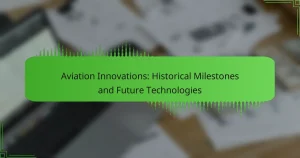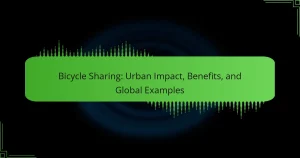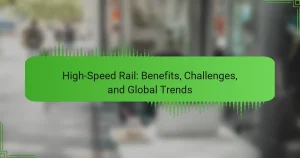Smart Transportation Systems enhance urban mobility by optimizing traffic flow and improving safety. This article explores key technologies driving integration, the challenges of implementation, and future prospects for sustainability. It also examines unique applications across different regions and strategies for optimizing system efficiency through data integration and user-centric design.
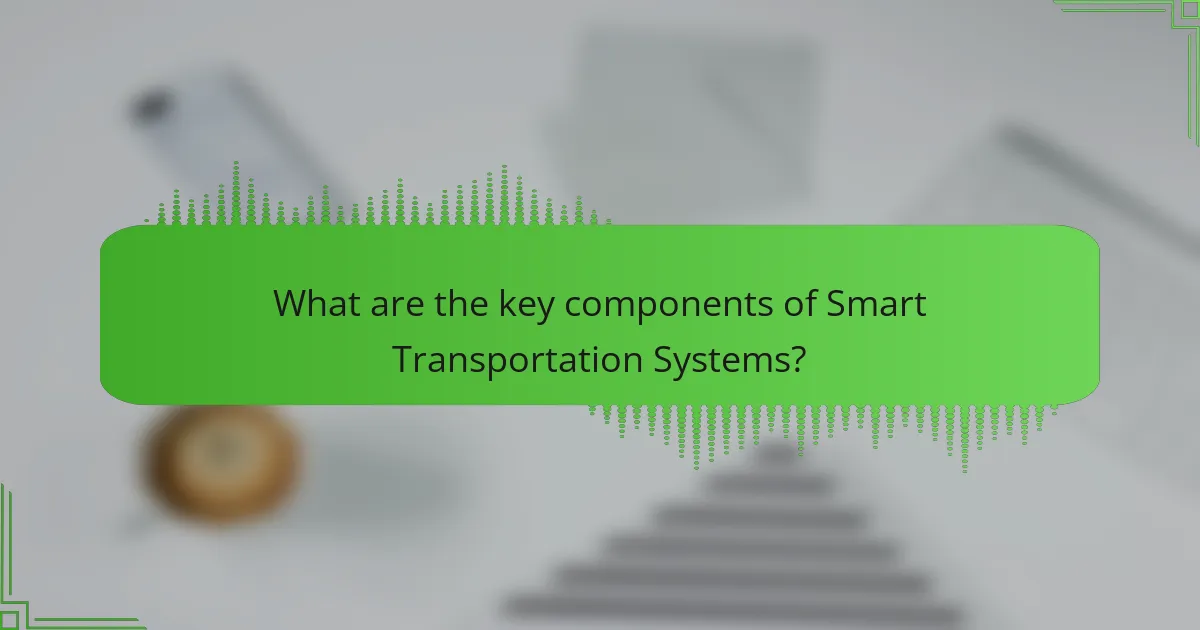
What are the key components of Smart Transportation Systems?
Smart Transportation Systems consist of various components that enhance efficiency and safety. Key components include intelligent traffic management systems, advanced vehicle technologies, and integrated communication networks. These elements work together to optimize traffic flow, reduce congestion, and improve overall transportation safety. Emerging technologies like autonomous vehicles and real-time data analytics further contribute to the evolution of smart transportation systems, promising a more connected and efficient future.
How do intelligent traffic management systems function?
Intelligent traffic management systems use real-time data to optimize traffic flow and reduce congestion. They integrate technologies such as sensors, cameras, and communication networks to monitor traffic conditions. These systems analyze data to adjust traffic signals, provide real-time information to drivers, and manage incidents efficiently. Future prospects include enhanced automation and integration with smart city initiatives, improving overall transportation efficiency.
What role do connected vehicles play in smart transportation?
Connected vehicles enhance smart transportation by enabling real-time data exchange, improving traffic efficiency, and reducing accidents. They utilize technologies like V2X communication, which connects vehicles with infrastructure, pedestrians, and other vehicles. This integration streamlines traffic management and optimizes routes, significantly decreasing congestion. Additionally, connected vehicles contribute to environmental sustainability by promoting eco-driving practices and reducing emissions. The future prospects of smart transportation systems hinge on the continued advancement of these technologies, potentially leading to fully autonomous vehicle networks.
How is data analytics utilized in transportation systems?
Data analytics enhances transportation systems by optimizing operations, improving safety, and enhancing user experience. It processes large datasets to analyze traffic patterns, predict demand, and manage resources effectively. For example, real-time data analytics enables dynamic traffic signal control, reducing congestion and travel time. Additionally, predictive analytics can forecast maintenance needs for infrastructure, ensuring reliability and safety. The integration of data analytics in smart transportation systems leads to more efficient, sustainable, and user-friendly urban mobility solutions.
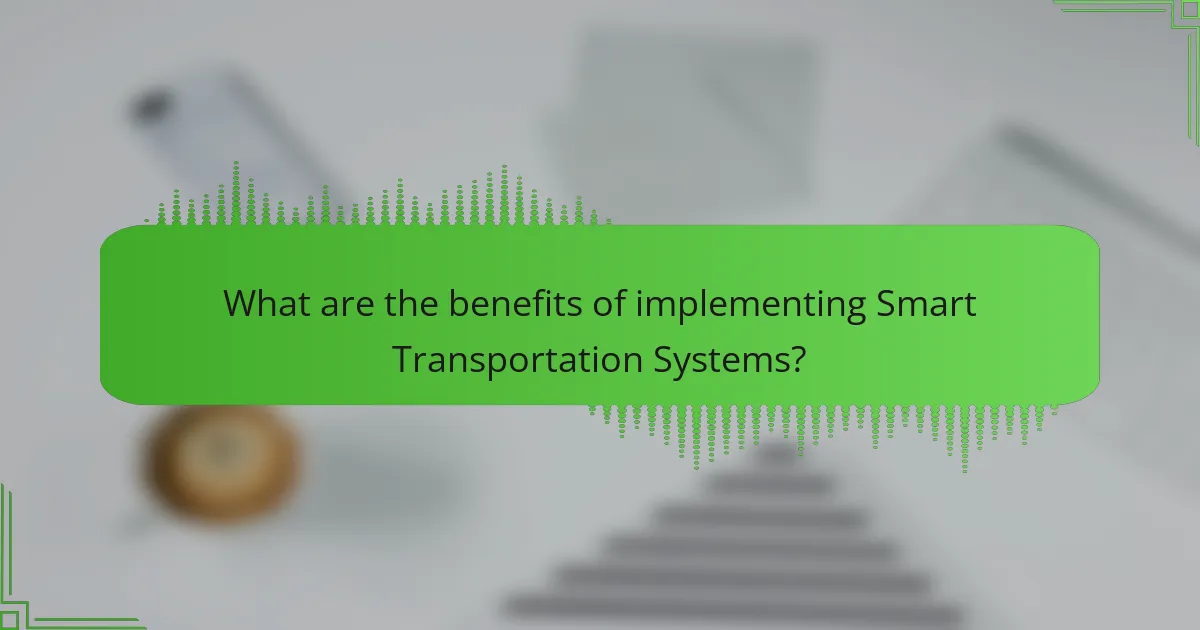
What are the benefits of implementing Smart Transportation Systems?
Implementing Smart Transportation Systems enhances efficiency, safety, and sustainability in urban mobility. These systems optimize traffic flow, reduce congestion, and lower emissions. For instance, real-time data integration enables adaptive traffic signals, improving travel times by up to 25%. Additionally, smart systems facilitate better public transport coordination, increasing ridership and user satisfaction. The adoption of these technologies leads to smarter cities, fostering economic growth and improved quality of life for residents.
How do these systems enhance road safety?
Smart transportation systems enhance road safety through real-time data sharing, automated traffic management, and advanced vehicle technologies. These systems reduce accidents by improving situational awareness and enabling quick responses to hazards. For example, connected vehicles communicate with traffic signals to optimize flow and minimize congestion, which decreases the likelihood of collisions. Additionally, predictive analytics can identify high-risk areas, allowing for targeted interventions. Overall, the integration of these technologies leads to safer road environments and more efficient traffic management.
In what ways do Smart Transportation Systems improve traffic efficiency?
Smart Transportation Systems enhance traffic efficiency by optimizing traffic flow, reducing congestion, and improving safety. These systems utilize real-time data analytics and communication technologies to manage traffic signals and monitor vehicle movements.
For example, adaptive traffic signals adjust timing based on current traffic conditions, which can decrease wait times by up to 30%. Additionally, integrated navigation apps provide drivers with optimal routes, further alleviating congestion.
The use of smart sensors and cameras also allows for better incident detection and response, which can reduce accident-related delays. Overall, these technologies lead to smoother traffic operations and lower emissions.
How do they contribute to environmental sustainability?
Smart transportation systems significantly enhance environmental sustainability by reducing emissions and optimizing resource use. They integrate various technologies to streamline traffic flow and promote energy-efficient travel options.
These systems utilize real-time data analytics, enabling efficient route planning and minimizing fuel consumption. For instance, adaptive traffic signals can decrease congestion, leading to lower greenhouse gas emissions. Additionally, smart public transportation options encourage the use of shared mobility, further reducing the number of vehicles on the road.
Investments in electric and hybrid vehicles within these systems contribute to cleaner air and reduced reliance on fossil fuels. As a result, cities adopting smart transportation technologies can achieve substantial improvements in air quality and overall urban sustainability.
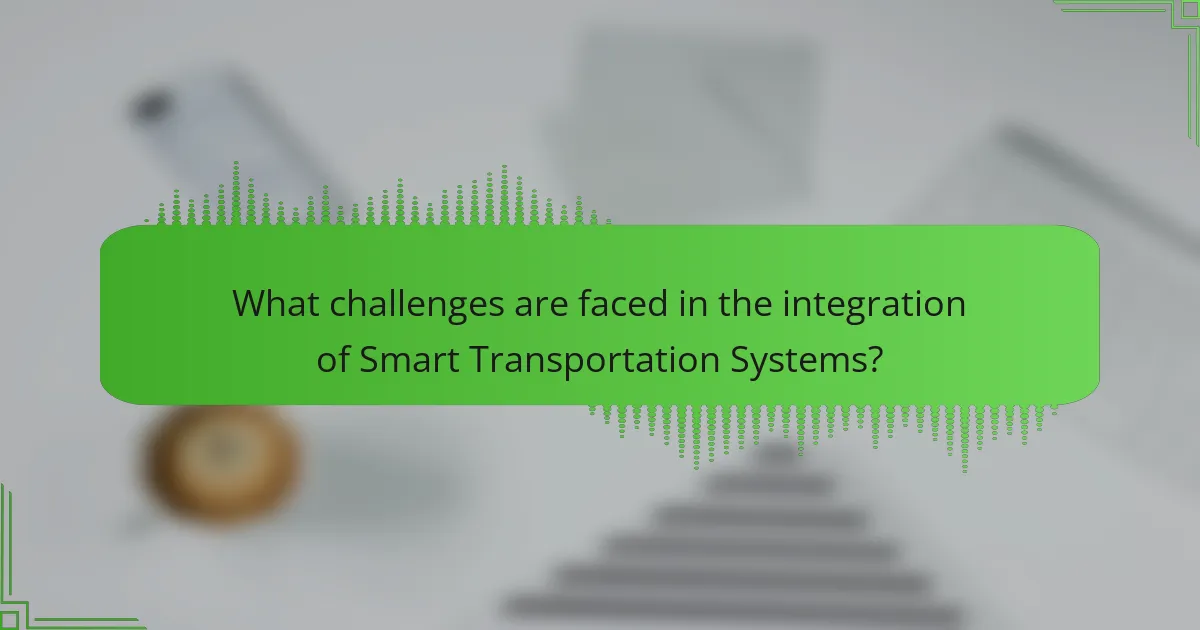
What challenges are faced in the integration of Smart Transportation Systems?
The integration of Smart Transportation Systems faces several challenges, including interoperability, data security, and user acceptance. Interoperability issues arise from diverse technologies and standards that hinder seamless communication between systems. Data security is critical, as increased connectivity exposes systems to cyber threats. User acceptance is essential for successful implementation, as resistance to change can impede adoption. Additionally, funding and regulatory hurdles can slow progress, impacting the overall effectiveness of these systems.
What are the technical barriers to implementation?
Technical barriers to implementing smart transportation systems include high costs, interoperability issues, data privacy concerns, and infrastructure limitations. These challenges hinder seamless integration of technologies and effective communication between systems. For instance, the need for standardized protocols complicates collaboration between different entities, creating unique hurdles for deployment. Additionally, legacy systems often require significant upgrades or replacements, posing further obstacles to implementation.
How do regulatory frameworks impact system development?
Regulatory frameworks significantly shape the development of smart transportation systems by establishing guidelines and standards. These regulations ensure safety, interoperability, and environmental compliance, influencing technology integration and deployment. For example, data privacy laws affect how systems collect and share user information. Compliance with standards fosters public trust and encourages investment in innovative technologies. As a result, regulatory environments can either accelerate or hinder advancements in smart transportation infrastructure.
What are the public acceptance challenges associated with these systems?
Public acceptance challenges for smart transportation systems include concerns about privacy, safety, and reliability. Users often fear data misuse and potential accidents. Additionally, the complexity of technologies can lead to skepticism. Education and transparency are essential to overcome these barriers. Engaging communities in the development process can foster trust and acceptance.
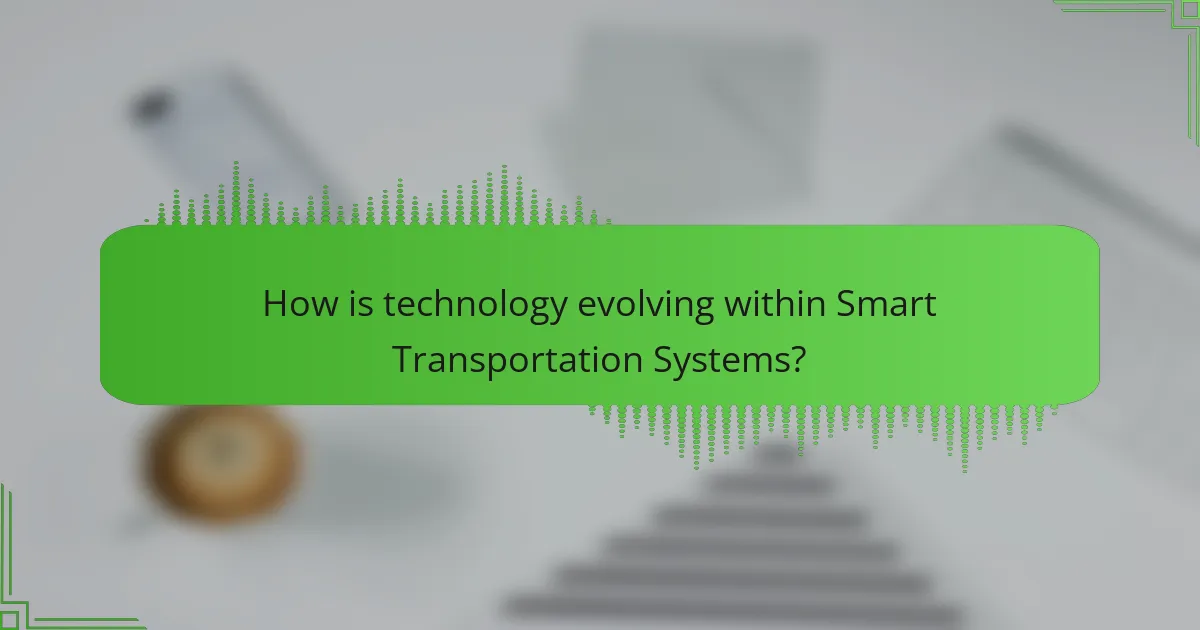
How is technology evolving within Smart Transportation Systems?
Technology is evolving rapidly within Smart Transportation Systems through advancements in data analytics, IoT, and AI. These technologies enhance traffic management, improve safety, and optimize public transit efficiency. For instance, real-time data collection from sensors allows for dynamic traffic signal adjustments, reducing congestion by up to 30%. Unique attributes like vehicle-to-everything (V2X) communication enable vehicles to interact with infrastructure, enhancing overall system responsiveness. As a result, the future of smart transportation promises increased sustainability and reduced environmental impact through smarter energy use and lower emissions.
What emerging technologies are shaping smart transportation?
Emerging technologies such as artificial intelligence, IoT, and autonomous vehicles are shaping smart transportation. These innovations enhance efficiency, safety, and connectivity within transportation systems.
Artificial intelligence optimizes traffic management and predictive maintenance. IoT devices facilitate real-time data sharing, improving route planning and vehicle monitoring. Autonomous vehicles promise to reduce accidents and improve mobility for all users.
Electric vehicles are also gaining traction, contributing to sustainability efforts. Smart infrastructure, including connected traffic signals and smart parking solutions, further enhances urban mobility.
The integration of these technologies creates a more efficient and user-friendly transportation ecosystem, paving the way for future advancements.
How do artificial intelligence and machine learning enhance these systems?
Artificial intelligence and machine learning significantly enhance smart transportation systems by optimizing traffic management, improving safety, and enabling predictive maintenance. These technologies analyze vast amounts of data in real-time, allowing for dynamic route adjustments and efficient resource allocation. For instance, AI algorithms can predict traffic patterns, reducing congestion and travel times. Additionally, machine learning models can identify potential hazards, enhancing safety measures. As a result, the integration of these technologies leads to more efficient, safer, and sustainable transportation networks.
Which innovative solutions are being tested in urban environments?
Innovative solutions in urban environments include smart transportation systems that utilize advanced technologies for efficiency. These systems integrate real-time data, autonomous vehicles, and sustainable energy sources. For example, cities are testing electric buses with AI-driven route optimization to reduce congestion and emissions. Additionally, smart traffic lights adapt to traffic flow, improving overall mobility. As a result, urban areas are becoming more connected and environmentally friendly, showcasing the future prospects of transportation.

What are the future prospects for Smart Transportation Systems?
Smart Transportation Systems are poised for significant advancements, driven by integration of technologies. Future prospects include enhanced safety through real-time data, reduced congestion via smart traffic management, and increased efficiency with electric and autonomous vehicles. As cities adopt these systems, the focus will shift towards sustainability, improving urban mobility, and minimizing environmental impact. These developments will create a seamless transportation experience, benefiting both users and urban planners.
How might autonomous vehicles transform transportation infrastructure?
Autonomous vehicles will significantly transform transportation infrastructure by enhancing efficiency and safety. Smart transportation systems will integrate real-time data analytics, enabling adaptive traffic management. This shift will reduce congestion and optimize road usage. Moreover, infrastructure will evolve with dedicated lanes and charging stations for autonomous vehicles, ensuring seamless operation. As a result, urban planning will prioritize multimodal transport solutions, fostering sustainable mobility.
What is the potential for integration with smart city initiatives?
Smart transportation systems have significant potential for integration with smart city initiatives. They enhance urban mobility, reduce congestion, and improve safety through real-time data sharing and advanced technologies.
Integration can leverage various technologies such as IoT sensors, AI analytics, and connected vehicles. These systems can optimize traffic flow, manage public transport schedules, and facilitate seamless communication between vehicles and infrastructure.
Moreover, smart transportation can contribute to sustainability goals by promoting electric vehicle usage and reducing emissions. As cities evolve, the collaboration between smart transportation and urban planning will be crucial for creating efficient, livable environments.
Future prospects include the expansion of autonomous vehicles and smart traffic management systems, which will further enhance the interconnectedness of urban infrastructure and improve overall quality of life.
Which trends are expected to influence the future of transportation by 2025?
Smart transportation systems will be shaped by automation, electrification, and data integration by 2025. These trends enhance efficiency, reduce emissions, and improve user experience.
Automation will drive the adoption of autonomous vehicles, leading to safer and more efficient transportation networks. Electrification will promote the use of electric vehicles, reducing reliance on fossil fuels and lowering greenhouse gas emissions.
Data integration will enable real-time traffic management, optimizing routes and reducing congestion. Advanced analytics will support predictive maintenance, enhancing the reliability of transportation infrastructure.
As a result, the convergence of these trends will create more sustainable, efficient, and user-friendly transportation systems, transforming urban mobility.
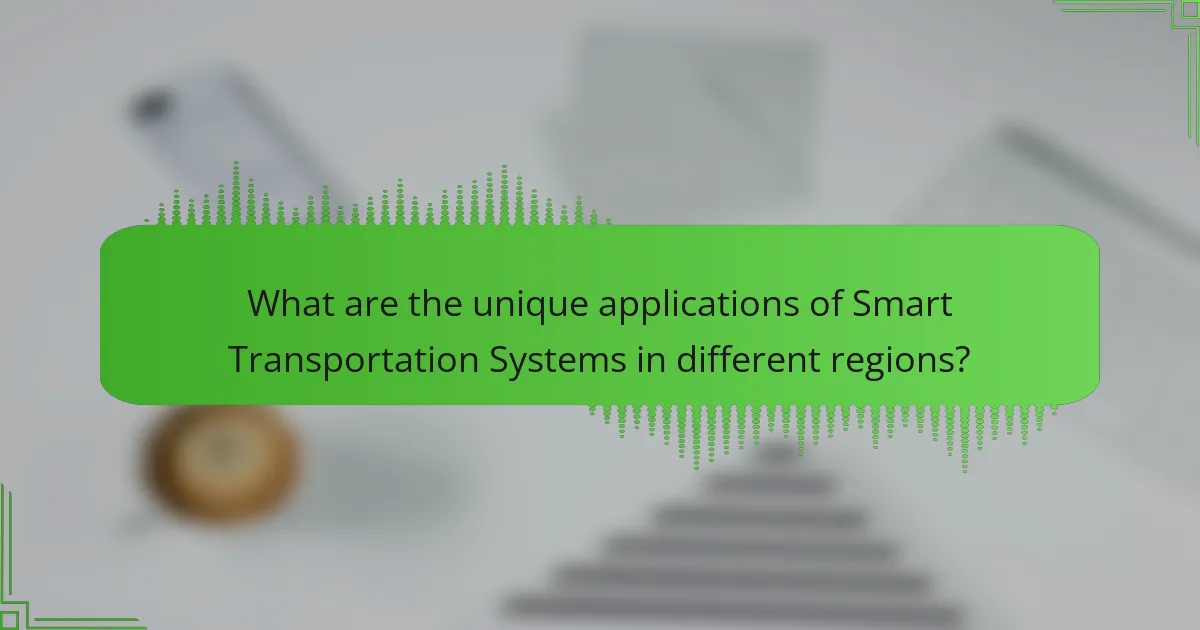
What are the unique applications of Smart Transportation Systems in different regions?
Smart Transportation Systems are uniquely applied across regions to enhance efficiency and sustainability. In urban areas, systems like real-time traffic management reduce congestion. In rural regions, smart logistics optimize freight transport. Developing countries utilize mobile apps for public transit information, improving accessibility. Advanced analytics in smart cities predict transport patterns, enhancing infrastructure planning.
How are Smart Transportation Systems tailored for densely populated urban areas?
Smart Transportation Systems are customized for densely populated urban areas by enhancing efficiency and reducing congestion. These systems utilize real-time data, smart traffic signals, and integrated public transit to optimize travel routes. Advanced technologies like AI and IoT facilitate seamless communication among vehicles, infrastructure, and users. Additionally, unique attributes such as adaptive traffic management and multimodal transport integration cater specifically to urban density challenges, improving mobility and sustainability.
What specific adaptations are made for rural transportation needs?
Smart transportation systems adapt to rural transportation needs through specialized technologies and infrastructure. These adaptations include low-cost vehicles, improved road conditions, and enhanced connectivity.
1. **Vehicle Design**: Vehicles are often smaller and more fuel-efficient to navigate narrow rural roads.
2. **Road Infrastructure**: Investment in rural road maintenance increases accessibility and safety.
3. **Digital Platforms**: Mobile apps facilitate ride-sharing and public transport scheduling, enhancing user convenience.
4. **Data Utilization**: Smart systems use data analytics to optimize routes and reduce travel time.
5. **Community Engagement**: Local input shapes transportation solutions, ensuring they meet specific rural needs.
6. **Sustainability Initiatives**: Emphasis on eco-friendly transport options supports environmental goals and reduces emissions.
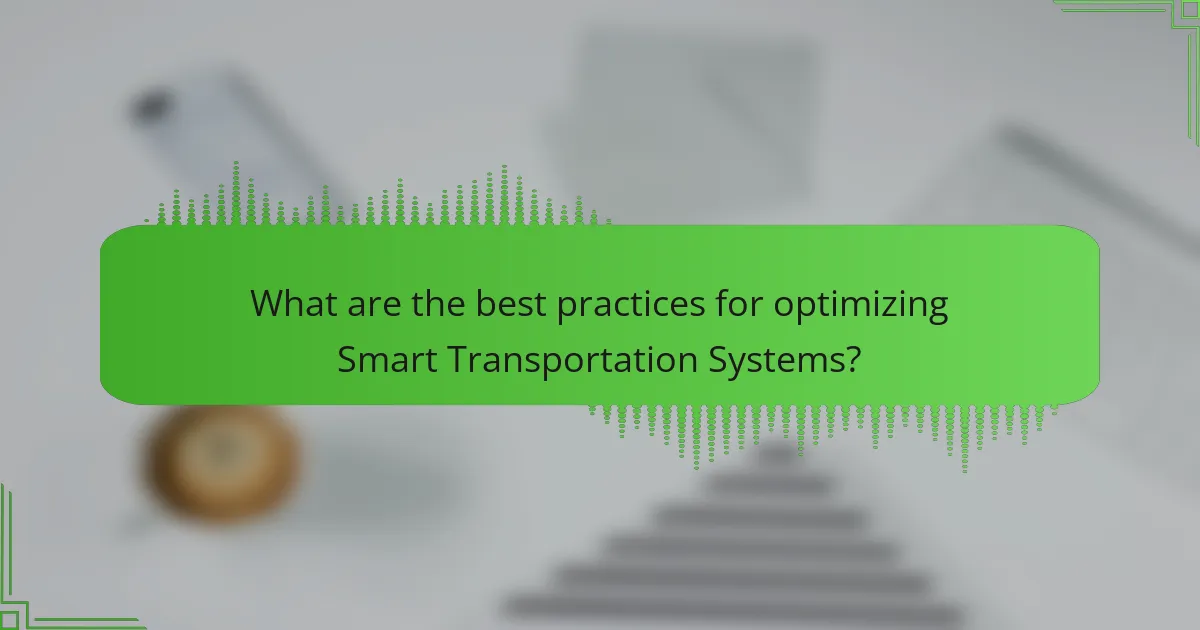
What are the best practices for optimizing Smart Transportation Systems?
To optimize Smart Transportation Systems, focus on data integration, real-time communication, and user-centric design. Implementing IoT technologies enhances connectivity and efficiency. Prioritize interoperability among systems to facilitate seamless data exchange. Continuous evaluation and adaptation based on user feedback ensure the system meets evolving needs.
How can cities effectively plan for smart transportation integration?
Cities can effectively plan for smart transportation integration by adopting a comprehensive approach that emphasizes technology, collaboration, and sustainability. Key strategies include enhancing data sharing among agencies, investing in infrastructure upgrades, and prioritizing user-centric design.
1. Foster collaboration between public and private sectors to develop integrated platforms.
2. Utilize real-time data analytics to optimize traffic flow and public transport schedules.
3. Implement adaptive traffic signals that respond to real-time conditions.
4. Ensure accessibility for all users, including pedestrians and cyclists, in planning.
5. Promote electric and autonomous vehicles to reduce emissions and improve efficiency.
By focusing on these areas, cities can create a cohesive smart transportation ecosystem that meets current and future mobility needs.
What strategies ensure successful stakeholder collaboration?
Successful stakeholder collaboration in smart transportation systems relies on clear communication, shared goals, and active engagement. Establishing a common vision fosters alignment among diverse parties. Regular updates and feedback loops enhance trust and adaptability. Utilizing collaborative technologies streamlines coordination and information sharing, ensuring all stakeholders are informed and involved.
What common mistakes should be avoided in system deployment?
To avoid common mistakes in system deployment for smart transportation systems, focus on thorough planning and stakeholder engagement. Neglecting these areas can lead to integration issues and user resistance.
Key mistakes include insufficient testing, which can result in system failures; overlooking data security, risking user privacy; and failing to provide adequate training for users, leading to operational inefficiencies. Additionally, ignoring feedback from end-users can hinder system improvements and user satisfaction.
Properly addressing these aspects ensures a smoother deployment process and enhances the effectiveness of smart transportation systems.
